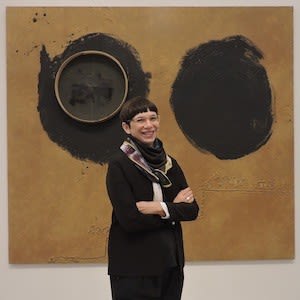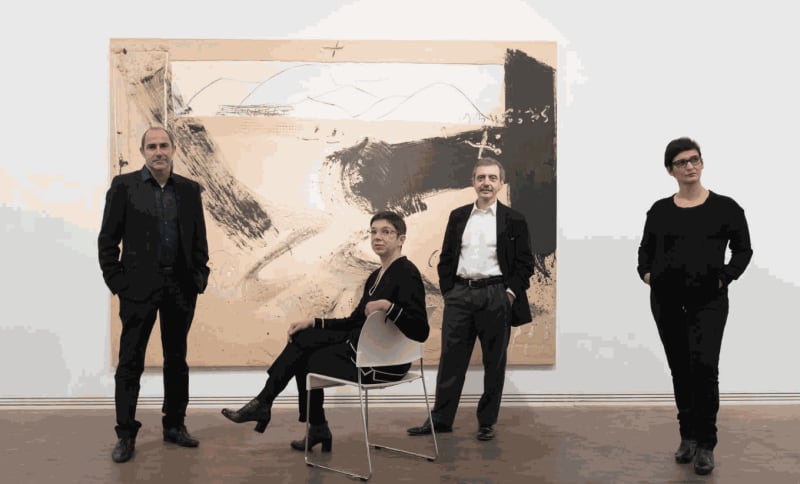An Interview with Laurence Rassel
Director of the Fundació Antoni Tàpies 2008-15 Brussels, by telephone, 24 July 2018
Llucià Homs: What was your personal experience in the seven years you were in charge of the Fundació?
Laurence Rassel: Let’s see how we handle this, because as you know I’ve lived through some very sad times [she gets emotional]. I’m sorry, the first thing that comes to me is this emotion, because I lived through the death of Antoni and of Miquel Tàpies at very close quarters. So if we’re speaking personally about this…
LH: I’m sorry the question’s so direct…
LR: [She recovers]. It’s because I hadn’t prepared for it. It was a privilege to work in tandem with them; at the same time I lived through the trauma of losing them at that moment. I was there during the transformation of the building which began with Nuria Enguita, and my role was in that moment of transition. Actually, I was incapable of imagining how long the transition would go on, because the death of Antoni and Miquel also meant coordinating this bridging role. Bear in mind that with Miquel I worked a lot, and during all those years I had a very intimate, very physical, relationship with the work of Antoni Tàpies.
We organized many exhibitions about the human body, we worked with Valentín Roma, we introduced performance and sound into the Fundació space. And on top of that there was all the experience of refurbishing the building. We were able to explore the reactions to it with the public, the relationship with other buildings by Domènech i Montaner, we worked on the archive and on how to make the work visible.
I always spoke of the Fundació Antoni Tàpies as an energy centre in which to take risks, of a place with a capacity to generate thoughts, ideas, gestures that might be a bit daring for other institutions. Because there was also the protection—if I can put it this way—of the work of Tàpies. It was a matter of bringing the public closer to the inner workings of the Fundació while proposing a space for work, for research, with all its past exhibitions and with the work of Tàpies.
LH: What did it mean for you to come in and direct the Fundació after the eight years of Manuel Borja-Villel and the ten of Nuria Enguita, with their social praxis and their exhibitions, which became landmarks?
LR: [Laughter] What was important was to work on opening up the archives, on making visible all the history there was behind things. Manuel and Nuria made history, they organized landmark exhibitions, but this building has a history that is not only generated by individuals. This institution permits risks, which we took, and yes, some landmark exhibitions are still out there in the world.
For me it meant the will to maintain all the Fundació’s expressivity. Despite all the circumstances we lived through, of political, economic or personal change, this is the story of an artist who offers a collection of his work as the basic material that allows other men and women artists to develop their work. It was, and is, incredibly generous. We’re not speaking of a foundation of artists that they themselves reproduce. Admittedly, the Fundació works on and also researches the work of Tàpies, but it goes way beyond that. The possibility existed to delve into the relationship with literature, with other artists, with music; a relationship between historical knowledge and another, freer aspect. Thus, it meant inscribing oneself in continuity at the same time as reflecting on the specificity of the institution.
LH: What place did the Fundació occupy in the artistic framework of Barcelona during those years?
LR: That’s a question I’d like you to put to other people, because what I tried to do was to introduce projects like the Sala d’Art Jove or Hangar in the Fundació. As you know, we collaborated with El Mercat de les Flors, with the MACBA, with other institutions, with schools, with individuals, with collectives, so the relationship was one of great closeness. The fact of making things visible and transparent called for a hospitable attitude, because there were spaces in which artists could talk and collectives could do workshops. We were after this transmission of energy, of knowledge.
After a period in which we were closed in order to adapt the building, we wanted to explain that the Fundació Antoni Tàpies was there, open, that it was a welcoming sort of place and at the same time a place of risk. My mission was to collaborate, stimulate, share and, as you say, this involves an historic imbrication which, right now, looks ambitiously towards the future. Let’s not forget we were able to accept this risk because of our particular nature, because other institutions have a different public role and must keep to a history. This was Miquel’s assignment when he invited me to open up this idea of projecting towards the future, with the possibility of accepting this risk.
LH: And how do you see the Fundació’s relationship with academia? Do you think it ought to play a key role in the study of the artist, facilitate doctoral theses, bring the work of the artist closer to the academic world?
LR: Yes, of course, this is obvious. As I was telling you, in my years there we opened the institutional archive so that students and teachers could come and work on the history of the Fundació’s exhibitions. I don’t know what the access to the Antoni Tàpies archive is like today, but of course it’s the source in which one can or must work and explore his oeuvre. But aside from that obvious fact, another thing is what type of relationship is established. This is specific to each country, each city, each institution.
LH: You, moreover, lived through a very difficult phase in economic terms. It was the time of the cutbacks and institutions had problems with financing. I remember the budget for culture was called into question.
LR: Yes, yes… but what do you expect? It was all I knew. I arrived in 2008 and the conditions were what they were. We worked and we had the possibility to take risks, to experiment, to go beyond the exhibition formats; we organized shows about the city, we worked in collaboration, we discovered artists. Despite this situation there was a closeness in the sector, so I felt very close. It was, and is, for sure, the way I work in this world, but also the circumstances in which we were living.
LH: And how do you see the trajectory of Tàpies today? How has it evolved? Do you think it’s speaking to young artists, to young curators?
LR: This is an interesting question, but my question would be, rather: Do you think it’s Tàpies who changes or is it we who do? I don’t know. It’s difficult because for me his work is a benchmark. I can’t dissociate myself from his work. As you know, I studied Fine Art and Tàpies was one of the artists I studied. I saw the work of Tàpies in Brussels and I read interviews, what was translated into French, but I never thought that one day I’d meet him for real and would work with him and with his oeuvre. For me Tàpies makes history, or rather, he is the history of art, and sure one can learn, above all from that generation which is physical with the material. Just look at what occurs around him: if you access his private collection you realize how curious Tàpies was about the world that surrounds him. For me he is—I don’t want to use the word model—kind of inspiring. A person who in this period studies, reads, listens, and his references can be very important for the artists of today. Look at the work relating to contemporary music, because I remember that when we did the Interval: Sound Actions exhibition at the Fundació, the director of the time from Toulouse said to me, “Ah, I thought that, yes, Tàpies could be in the exhibition with contemporary artists.”
The fact of uniting Tàpies with contemporary works or of protecting his ongoing contemporaneity, despite him being historically situated in another era, is the opposite of what a universal, timeless oeuvre might be. For me the fact that he’s situated in a specific historical and cultural time is what gives him the facility, the possibility, of relating to those contemporary practices. And if you look at Tàpies’s private collection, at his mental environment, you’ll see there was a kind of coexistence, it was a world of immense richness.
LH: How do you think the new generations of critics and curators are reading him today? Do you think he’s an artist who speaks to them or do you think they see him as a historical reference, one that’s distant and “dead”?
LR: [Laughter] Frankly, I don’t know, it will depend on how the questions are asked. For me it’s an oeuvre that’s not at all moribund, it’s a way of thinking that’s alive; meaning I can’t understand how someone might think that they can’t learn from looking at Tàpies’s work today. No, I can’t understand it.
LH: And do you think this is one of the Fundació’s missions, to update Tàpies’s run on for the new generation?
LR: Yes, of course, as you yourselves are doing as well. The Fundació obviously does it time and again. It was like we did with Valentín Roma, with experiments with contemporary artworks or by inviting other artists, giving visibility to these relationships. In short, yes, it’s one of the Fundació’s roles, but it’s also a role of all Tàpies lovers, so in the end it’s a collective responsibility.
LH: It’s the ambition of this exhibition to involve Arnau Puig so that he might bring his historical vision to bear, along with the visions of young curators of both sexes, in order to see how he interprets Tàpies today. That’s to say, given all that’s happening in the country, a lot of which Tàpies denounces in his works of the 1960s and 70s as to freedom of expression is very topical once again.
LR: Yes, what I would say is not so much that the work has changed, for his work is situated in the era in which it was created, but that it’s the alliances which enable Tàpies to be a travelling companion, one of the artists you can analyse with regard to these particular issues. Hence the fact that I think it’s so important to establish these links and relationships with other artistic practices, because it involves creating connections between a contemporary practice and its historical practice. By saying “this artist or this oeuvre is to my liking” you inscribe myself in the history, in the history of the works that denounce or that work or that are interpellated, affected by this or that politics.
LH: Laurence, thanks you very much for your time.
LR: Forgive my emotional outburst at the start. I can’t help it, what with everything that happened…
LH: Of course. Thank you for your frankness.
Published in Tàpies, today. Barcelona, 2019. Mayoral. p. 54 - 56
January 31, 2019





